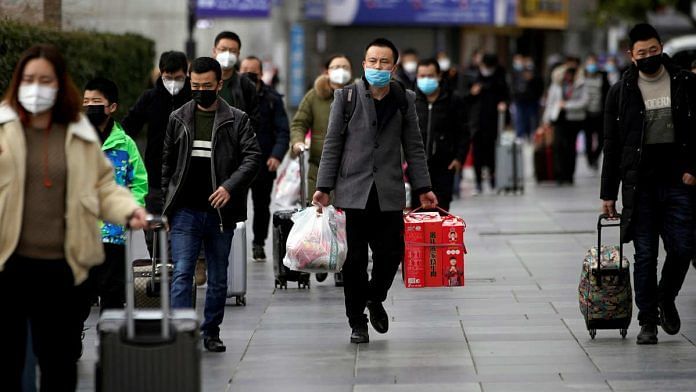In the grip of a new infection spreading around a planet with no natural immunity, it can feel like the sky is falling. Over the coming months, it’s likely that a significant share of the world’s population will experience some of the dread of the Covid-19 coronavirus that people in China have suffered over the past few months. Many will die.
Still, the likely end-point of this outbreak will see it settle down as an endemic disease — one of the suite of respiratory viruses like influenza and the common cold that travel around the world year after year, with most of us regarding them as little more than a nuisance.
The great unknown is what will happen along the way. Doing the sums can produce alarming figures. The best estimates so far suggest that Covid-19 kills about 1% of people it infects. That number may go up somewhat or fall significantly; either way it could add up to a dreadful toll.
If 60% of the world’s population is ultimately infected, as suggested by Gabriel Leung, chair of public health medicine at Hong Kong University, a 1% fatality rate would kill almost 50 million people — similar to the 1918 Spanish flu. If that falls to 0.1%, it could still be roughly 10 times more fatal than the 2009 H1N1 influenza outbreak, which killed several hundred thousand in its first year.
A better comparison might be the influenza pandemics that emerged from China in the 1950s and 1960s, according to Benjamin Cowie, a professor of epidemiology at the University of Melbourne — but the differences are still significant. While our health systems are far better than they were 50 years ago, the channels of infection are more open, too.
“We’re in a very different world now, our world is much more interconnected,” he said. “What happens in one place is much more likely to be on the other side of the world in 24 hours.”
Attempts to contain this infection in existing hot spots in Asia, the Middle East and Europe appear to be failing. If that’s the case, expect to see low-level movement restrictions spread elsewhere. Such measures don’t serve so much to eliminate as to slow down a highly contagious infection like Covid-19. Still, that will spread out the burden of sickness over a longer period, putting less pressure on the health system.
The biggest impact is likely to be on the young and old. Children are less able to carry out the basic hygiene and touch-avoidance measures that help slow infections, so school closures like those imposed in Hong Kong and now in Japan could crop up elsewhere.
Aged care homes may see even more serious restrictions. Covid-19 seems to particularly target the elderly and those with other existing conditions. One recent study of more than 72,000 cases in China found a fatality rate of 2.3% across all age groups, rising to 8% for people in their 70s and 15% for people above 80. Minimizing the risks to older people will probably put significant pressure on aged care facilities, especially if staff are infected themselves, or called away to look after children sent home from shuttered schools.
Also read: Hong Kong dog tests ‘weak positive’ for coronavirus, could be first case among pets
Fortunately, the most severe period of initial infection could soon be fading. Respiratory diseases flourish in the cold season and taper off as the weather warms up. That should cause infection rates to slow in the northern hemisphere, while continuing at a lower level in tropical regions and spiking in temperate parts of the southern hemisphere where winter will be setting in. When a new year rolls around, the bulk of the disease will shift back to the northern hemisphere, to begin the cycle again.
Subsequent Covid-19 seasons probably won’t be as serious. Those who survive viruses should be immune from reinfection (though there have been reports of people being diagnosed with Covid-19 for a second time), and as the share of survivors in the population rises, it gets harder for a disease to spread.
“Most influenza pandemics last two to three years,” said Peter White, a professor of virology at the University of New South Wales. “That’s how long it takes before herd immunity is built up.”
In a best-case scenario, it’s even possible that vaccines may be available in not much more than a year. On top of that, doctors and nurses will get better at treating the condition and preventing severe illness, both through improved clinical knowledge; use of antiviral medicines like Kaletra, if they’re found to be effective; and because they’ll be much better-equipped to handle the crisis when infection rates are lower and fewer people are crowding into hospitals and clinics.
There’s no cause for complacency. Epidemics often move in waves, so that an apparent early peak in infections can be followed by further surges. That’s reason to maintain vigilance around measures like hand-washing and touch-avoidance, even if the pandemic seems to be on the ebb.
All of this will affect society in ways hard to predict. A global economy that’s off sick will struggle to grow in the manner previously expected. A disease that so aggressively targets older people may even shift the demographic structure of populations. The large number of men who died in the 1918 Spanish flu and the First World War has often been cited as one reason why the social and economic position of women improved so much in the 1920s.
We’re not on the brink of doom. As we’ve written, taking modest and sensible precautions should keep most people safe. In time, Covid-19 may be remembered not so much with dread as with historical curiosity. But the coming months, and years, will change us.
Also read: Coronavirus death toll jumps to 2,835 in China, 594 more cases in South Korea






